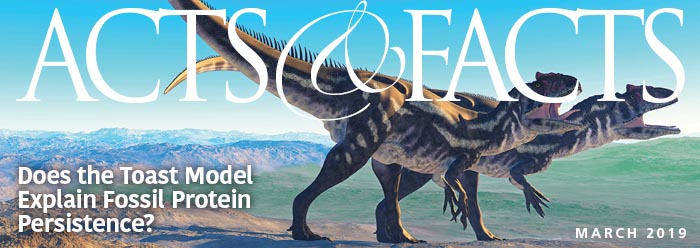At any given time, no matter where we are, we’re not far from those infamous arachnids the spiders, most of which are not a threat.1
Many feel a natural revulsion when they experience spiders up-close-and-personal, but like the mosquito,2 God had a plan for them in our ecosystem. What is immediately apparent is that spiders have always been spiders and did not evolve from a non-spider ancestor. Indeed, even fossil spiders are 100 percent spider.
Tufts of hairlike fibers seen on its legs showed this 165-million-year-old arachnid to be the oldest known species of the largest web-weaving spiders alive today—the golden orb-weavers, or Nephila.3
Going back even further in “evolutionary time” reveals two fossil spiders of the genus Eocteniza and Protocteniza from Coseley, England. They were found in sedimentary rock dated at “310 million years ago”—yet, as the creation model predicts, they’re still spiders.4
While creationists ponder the purpose of some aspects of spider physiology prior to the Fall, it’s now evident that their toxicity actually has the potential to save many people from starvation.
As the world’s population continues to grow at approximately 80 million souls per year, it’s important to make maximum use of the various food crops. Unfortunately, crops lost to insect pests is around 10 percent—food that could have nourished millions of people.5 Reducing this intolerable loss via traditional pesticides is costly, it adversely affects the environment, and insects are becoming increasingly resistant to the poison. (Insect resistance to pesticides is hardly “evidence of evolution.”6 The insects are the same genus and species before and after resistance acquisition.) One way of battling crop-destroying insects is to use more environmentally friendly compounds that are just as deadly to these pests. Nicotine is one such natural pesticide. It can be diluted and applied and has “a much lower acute mammalian toxicity and greater field persistence.”7
Oddly enough, using spider venom as a natural insecticide may be another method. Research biologists suggest using a peptide (a compound of two or more amino acids) isolated from spider venom that is poisonous to insects. This chemical is called “insecticidal spider-venom peptide,” or ISVP. Consider the benefits man has discovered from spider venom:
A large number of SS-rich insecticidal peptides have been isolated from spider venoms. Many of these have desirable properties for development as bioinsecticides, including high potency, rapid speed of kill, lack of vertebrate toxicity, low production costs, and activity against a wide range of crop pests and disease vectors.8
In regard to webs before the Fall, they could very well have been made as decorations, as some species do even today. Evolutionists state, “Exactly why the spiders adorn their webs is unclear….A team has made a discovery in one spider species that suggests the spiders use adornments ‘tactically’ to make their webs more visible to animals that might accidentally damage them.”9 One thing is certain—the webs before the Fall must have been large, spectacular, and beautiful. Indeed, spider silk has been found to conduct light almost as well as glass fiber, opening the door to biosensor, laser, and microchip research.10
But what was the purpose and function of spider venom before the Fall, when everything was very good? Creationist scientists continue to research and answers are becoming apparent—so stay tuned.
References
- Isbister, G. K. and H. W. Fan. 2011. Spider bite. Lancet. 378 (9808): 2039-2047.
- Sherwin, F. 2013. God’s Amazing Invertebrates: The Missing Links Are Still Missing. Acts & Facts. 42 (2): 12-15. See also Sherwin, F. 2013. Mosquitoes and the Fall. Acts & Facts. 42 (3): 9.
- Choi, C. Q. Largest Fossil Spider Found in Volcanic Ash. LiveScience. Posted on livescience.com April 19, 2011.
- Ibid.
- Oerke, E. C. 2006. Crop losses to pests. Journal of Agricultural Science. 144 (1): 31-43.
- Swift, D. 2002. Evolution Under the Microscope. Alloa, UK: Leighton Academic Press, 235-244.
- Insecticide. Wikipedia. Posted on wikipedia.org, accessed March 18, 2013.
- King, G. F. and M. C. Hardy. 2013. Spider-venom peptides: structure, pharmacology, and potential for control of insect pests. Annual Review of Entomology. 58 (January): 475-496.
- Gill, V. Spiders protect webs with decorations. BBC Nature News. Posted on bbc.co.uk May 25, 2011, accessed March 18, 2013.
- Stark, A. Eco-friendly Optics: Spider Silk’s Hidden Talents Brought to Light for Applications in Biosensors, Lasers, Microchips. The Optical Society. Posted on osa.org October 11, 2012, accessed March 18, 2013.
* Mr. Sherwin is Research Associate, Senior Lecturer, and Science Writer at the Institute for Creation Research.
Cite this article: Sherwin, F. 2013. What Are the Benefits of Spider Venom and Webs? Acts & Facts. 42 (5): 20.







